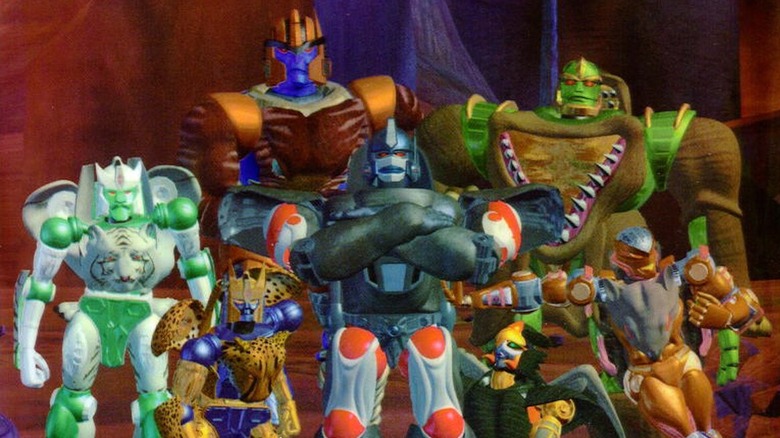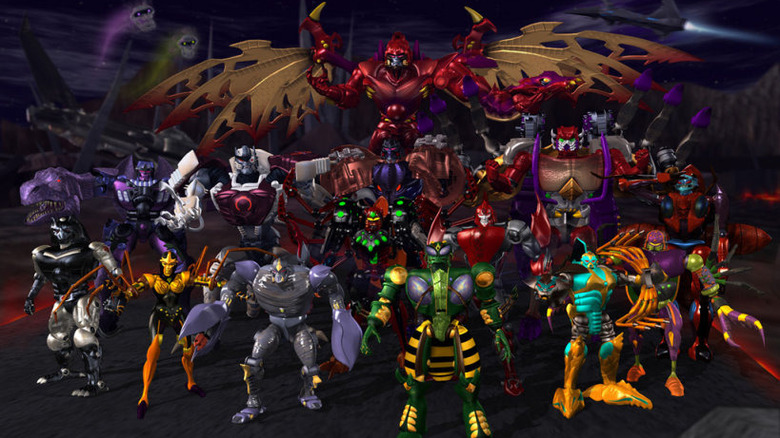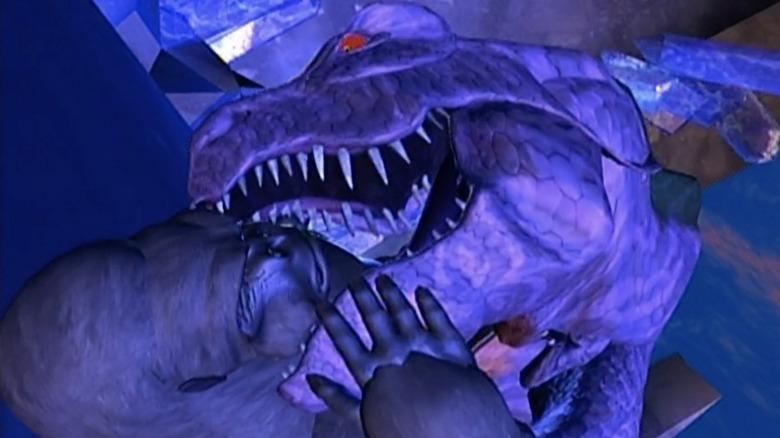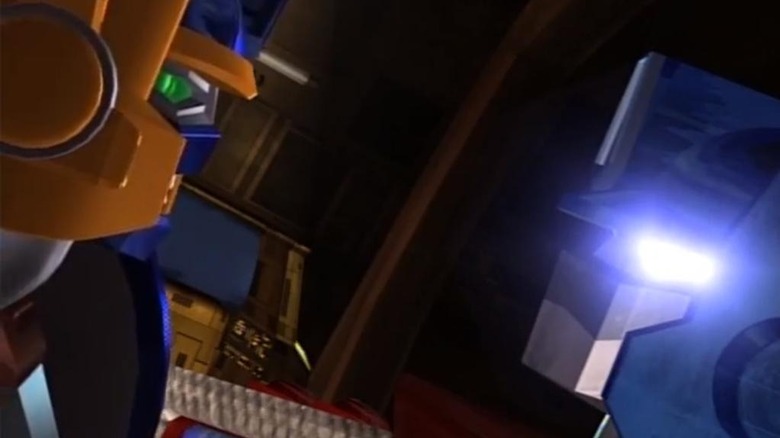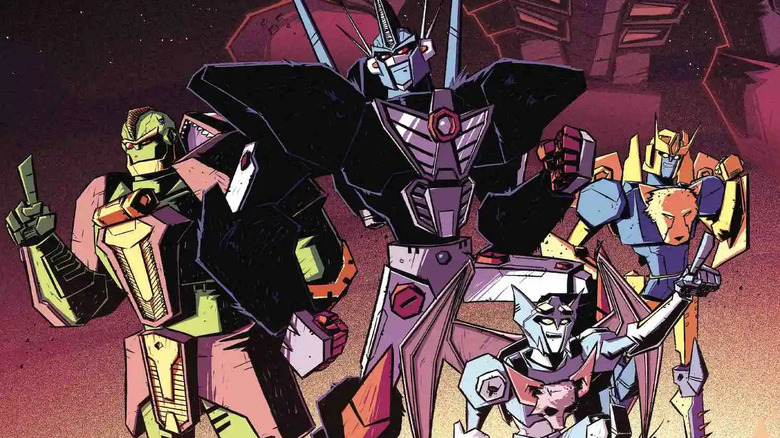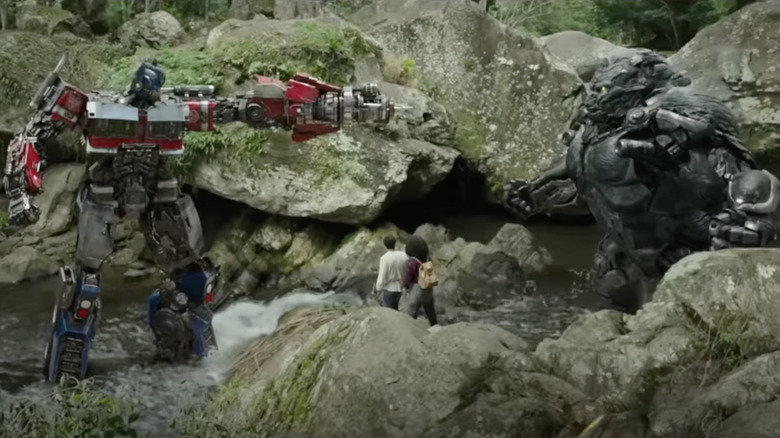Everything You Need To Know About Beast Wars To Be Ready For Transformers: Rise Of The Beasts
"Transformers: Rise of the Beasts" is set to introduce a whole new breed of Robot in Disguise. Instead of cars, trucks, or jets, these Transformers turn into beasts of all shapes and sizes. Known as the Maximals and Predacons, these animal transformers will soon be duking it out alongside their Autobot and Decepticon cousins.
The characters first debuted in the 1996 cartoon "Beast Wars." Despite how different it was from the "Generation One" series, not to mention later versions that take their cues from the original, "Beast Wars" is one of the most beloved "Transformers" iterations. It's usually the watermark that the quality of each subsequent "Transformers" cartoons is measured against.
The first trailer for "Transformers: Rise of the Beasts" was released today. Now that the "Transformers" film franchise is finally on solid footing after the pleasant surprise of 2018's "Bumblebee," can "Rise of the Beasts" measure up to the standard of that movie, and to "Beast Wars" itself?
Before the Beast Wars come to the silver screen, here's what you need to know about the history of this "Transformers" offshoot.
How Beast Wars came to be
Like all "Transformers," "Beast Wars" started with toys. The first "Transformers" toys, later known as "Generation One," were imported/refurbished by Hasbro in the 1980s from Japanese brands Diaclone and Micro Change. Thanks to changes in broadcast regulations, Hasbro was able to create an animated "Transformers" series that was basically a toy commercial with a story (to use the word loosely).
After the high of the brand's first few years, "Transformers" declined. The cartoon came to a close with a truncated fourth season, consisting of a three-part finale titled "The Rebirth." The toy line kept going until 1990, as did the comic series published by Marvel, but both suffered under the constant inclusion of new gimmicks.
Japan kept going; Hasbro counterpart Takara produced subsequent "Transformers" anime/manga ("Headmasters," "Super-God Masterforce," "Victory," and the "Zone" OVA) which followed on from the cartoon's ending. However, these were never imported stateside.
After repackaging some of the "Generation One" toys and episodes as "Generation 2" in 1992, Hasbro revamped the brand entirely with "Beast Wars." The original toy line had characters who turned into animals, such the fan-favorite Dinobots, but now all of the toys did so. If there's one thing kids like even more than cars and jets, it's cool animals and dinosaurs.
In keeping with "Transformers" tradition, a cartoon followed the toys. Animated by Mainframe Entertainment, "Beast Wars" was one of the first all-CGI cartoons. The series was overseen by Larry DiTillio and Bob Forward, two veteran cartoon writers (in fact, DiTillio had co-created "She-Ra: Princess of Power" alongside J. Michael Straczynski). It was the cartoon that gave "Beast Wars" a distinct identity and revitalized "Transformers."
Maximals wage their battle to destroy the evil forces of the Predacons
The earliest "Beast Wars" material framed the series as taking place on modern-day Earth. The Maximals and Predacons were simply new Autobots and Decepticons. Optimus and Megatron were likewise the originals. The cartoon took a different approach: the Maximals and Predacons were the descendants of the Autobots and the Decepticons. The war eventually ended in the Autobots' favor, leaving them in control of Cybertron and the Predacons/Decepticons marginalized.
"Beast Wars" picks up a few centuries after "Generation One." In the series premiere, a group of Predacon criminals and their Maximal pursuers are sent back in time by a wormhole, crash-landing on prehistoric Earth. They become robots in disguise, but not to blend in. The planet is covered in raw Energon; a refined version of this substance is the Transformers' fuel source, but the raw version emits damaging radiation. Both sides adopt animal alternate modes because the synthetic flesh protects their bodies from the Energon.
Instead of massive armies, the Maximals and Predacons usually number about half a dozen each (the series never shied away from casualties of war). The animation budget was the reason for this small cast, but it worked out for the best. The characters and their relationships were much more well-defined than in "Generation One," where 90% of the cast was lucky to get 1 starring episode.
Optimus Primal was not the stalwart Optimus Prime, but a more flawed and untested leader. Megatron wasn't a tyrannical warrior but a slimy, scheming upstart — not to mention shockingly competent for a cartoon villain. The series' other stars included the wisecracking Rattrap, the Predacon-to-Maximal defector Dinobot, and the harmless buffoon Waspinator (side-note: all three were voiced by the super-talented Scott McNeil).
Connections to Generation One
Neither DiTillio or Forward came to "Beast Wars" as "Transformers" fans. DiTillio even told an online fan group, "Both Bob and I are fully aware of the old show and we are adamant about producing a BETTER show." Indeed, their lack of fandom turned them into more innovative storytellers. DiTillio introduced the concept of "Sparks," energy orbs concealed in a Transformer's chest which was both their heart and soul. Sparks have since become a cornerstone of "Transformers" lore.
Still, the setting was irrevocably tied to "Generation One" and these connections grew as the series went on. Season 1 episode "Possession" featured an appearance by the Decepticon Starscream, building on the "Generation One" episodes where he'd returned as a ghost.
This came to a head in the season 2 finale "The Agenda." In "Generation One," the Autobots and Decepticons crash-landed on Earth and slumbered for four million years before awakening in 1984. This finale revealed that Megatron had come to Earth to rewrite history; unearthing an Autobot ship called The Ark, he planned to kill the dormant Optimus Prime to ensure a Decepticon victory and, by extension, a Predacon-ruled Cybertron.
Beast Wars' legacy
"Beast Wars" ran for three seasons and 52 episodes between 1996 and 1999. It was followed by a sequel, "Beast Machines," where the Maximals returned to Cybertron only to find it overrun with mindless "Vehicons" controlled by Megatron.
"Beast Machines" was ambitious, perhaps too much so, lasting only two seasons and 26 episodes. According to former Hasbro executive Aaron Archer, the polarized reception of "Beast Machines" doomed a second "Beast Wars" sequel called "Transtech."
Japan again took the lead in "Transformers" animation, but this time, Hasbro imported the anime. In 2001, "Car Robots" became "Robots in Disguise." In a bizarre twist on the formula, this series had the Autobots, who turned into vehicles, fighting the Predacons, who turned into animals. "Transformers: Cybertron" ("Galaxy Force" in Japan) also featured Jungle Planet/Animatros, a planet inhabited entirely by animal Transformers.
In 2007, Hasbro finally produced an American "Transformers" cartoon again. The head writer of "Transformers: Animated" was Marty Isenberg, who'd worked on "Beast Machines." "Animated" thus featured Waspinator and his fellow "Beast Wars" character Blackarachnia as supporting characters. Following series "Transformers: Prime" reimagined the Predacons as draconic Transformers who preceded the humanoid Cybertronians. The Decepticon Shockwave managed to recreate a Predacon, dubbed "Predaking."
2021, the 25th anniversary of "Beast Wars," heralded a surge in prominence. IDW Comics launched a new "Beast Wars" series, retelling the cartoon's story — this was unfortunately cut short due to the company losing its "Transformers" publishing license. The third season of Netflix's "War for Cybertron: Kingdom" featured most of the "Beast Wars" cast alongside the Autobots and Decepticons. That brings us to "Rise of the Beasts."
Rise of the Beasts
In the "Rise of the Beasts" trailer, fans can spot some familiar faces: the Maximals Cheetor, Rhinox, Airazor, and Optimus Primal himself. Primal, who comes face-to-face with Optimus Prime, indicates the movie Maximals are from the Autobots' future, just like their original selves. Unlike their cartoon counterparts, these Maximals are as big as other Transformers, not human-sized. They're also more visibly robotic, even in beast mode.
So far, the Predacons are nowhere to be seen. Instead, the Autobots and Maximals will be fighting a group called the Terrorcons. That name has been used liberally in past "Transformers" shows, meaning anything from Decepticons who turn into fantasy beasts to Transformer zombies. The "Rise of the Beasts" Terrorcons seem to be a new take altogether.
Just as interesting is their leader, Scourge. There are three major characters in "Transformers" fiction with that name, but none of them come from "Beast Wars." Instead, this Scourge seems most inspired by the "Car Robots"/"Robots in Disguise" version. In that series, Scourge ("Black Convoy" in the original Japanese) was an evil clone of Optimus Prime created by the Predacons. In "Rise of the Beasts," Scourge transforms into a black truck, mirroring the Autobot leader, but whether he has the same backstory remains unclear for now.
I'll admit I've been apprehensive about "Transformers: Rise of the Beasts." After the delightful back-to-basics of "Bumblebee," bringing in the complicated story of "Beast Wars" seems a risky move. If "Rise of the Beasts" doesn't disappoint, though, then this will be the second time that "Beast Wars" helped save "Transformers."
